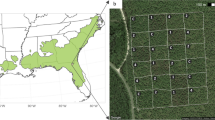Abstract
Natural forest communities consist of different overlapping elementary subpopulations. Using the results of forest stratification in the preceding study, the properties of mean tree height for subpopulation in a stratified forest stand were examined. Mean tree height decreased as tree density per subpopulation increased. This relation was described by a simple mathematical model consisting of a power equation of tree density and two coefficients. The first coefficient or exponent of tree density was close to −1/2 in its expectation, while the other coefficient depended on life forms, especially in tropical forests. For tropical deciduous forests which suffered from seasonal forest fires, the latter coefficient was smaller than those for tropical evergreen and Japanese forests. This difference of the coefficient was not clear between tropical evergreen and Japanese forests and between deciduous and evergreen forests in Japan. In conclusion, the proposed model is similar to the 1/2 power law of tree height in man-made forests with simple architecture, and is designated the quasi-1/2 power law of tree height.
Similar content being viewed by others
Abbreviations
- ha:
-
hectare (=10000 m2)
References
Ando, T. 1962. Growth on the natural stands of Japanese red pine (Pinus densiflora Sieb. et Zucc.). II. Analysis of stand density and growth. Bull. Govt. For. Expt. Stan., Tokyo147: 45–77.
— 1968. Ecological studies on the stand density control in even-aged pure stand. Bull. Govt. For. Expt. Stan., Tokyo210: 1–153.
Davis, T.A.W. andP.W. Richards. 1933. The vegetation of Moraballi Creek, British Guiana: an ecological study of a limited area of tropical rain forest. Part I. J. Ecol.21: 350–384.
Grubb, P.J., J.R. Lloyd, T.P. Pennington andT.C. Whitmore. 1963. A comparison of montane and lowland rain forest in Ecuador. I. The forest structure, physiognomy, and floristics. J. Ecol.51: 567–601.
Nagano, M. and T. Kira. 1978. Aboveground biomass.In T. Kiraet al., ed., Biological Production in a Warm Temperate Eveergreen Oak Forest of Japan, JIBP Synthesis18: 69–82.
Richards, P.W. 1952. The Tropical Rain Forest (Reprinted with corrections 1979). Cambridge Univ. Press, Cambridge.
Shidei, T. 1956. Problems of Stand Density. Japan Forest Technical Society, Tokyo (in Japanese).
Tadaki, Y. 1963. The pre-estimating of stem yield based on the competition-density effect. Bull. Govt. For. Expt. Stan., Tokyo154: 1–19.
— 1964. Effect of thinning on stem yield volume studied with competition-density effect: on the case ofPinus densiflora. Bull. Govt. For. Expt. Stan., Tokyo166: 1–22.
— andT. Shidei. 1963. The ecological studies on the quantitative thinning. Bull. Kyoto Univ. For.34: 1–31.
Yamakura, T. 1985. Tree height distribution inChamaecyparis obtusa plantations (Frequency distribution of individual weight, stem diameter and height in plant stands. XI). Jap. J. Ecol.35: 345–355.
— 1987. An empirical approach to the analysis of forest stratification. I. Proposed graphical method derived by using an empirical distribution function. Bot. Mag. Tokyo100: 109–128.
Yoda, K., T. Kira, H. Ogawa andK. Hozumi. 1963. Self-thinning in overcrowded pure stands under cultivated and natural conditions (Intraspecific competition among higher plants XI). J. Biol. Osaka City Univ.14: 107–129.
Author information
Authors and Affiliations
Rights and permissions
About this article
Cite this article
Yamakura, T. An empirical approach to the analysis of forest stratification. Bot Mag Tokyo 101, 153–162 (1988). https://doi.org/10.1007/BF02488892
Received:
Accepted:
Issue Date:
DOI: https://doi.org/10.1007/BF02488892




